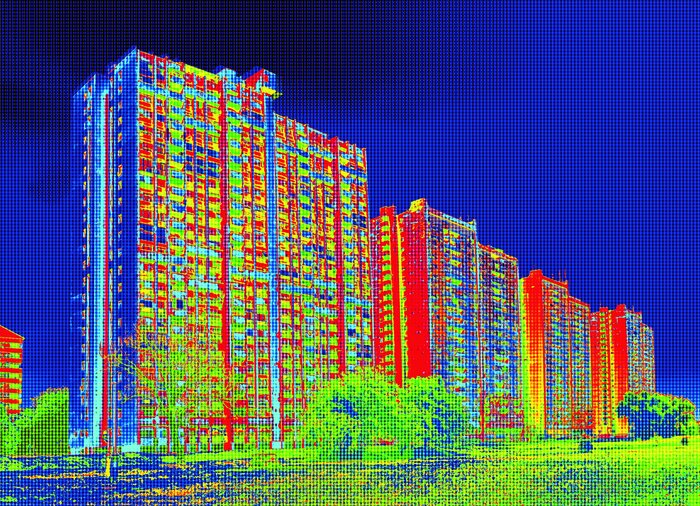Renovate existing buildings

We expect more and more from our buildings. We not only want them to be smart, now they also need to be cognitive – they have to be independent so that they can think for us. They not only need to benefit the environment, they must be sustainable through and through. And above all, the space provided and the fittings and equipment should suit our lives. But even our lives are in transition. The way young generations live, work and consume is very different from their parents and grandparents. Barrier-free housing is becoming increasingly important for an aging society. Even the COVID-19 pandemic has had a lasting effect on the demands we place on buildings. Do all these new demands mean that we need new buildings? Fortunately not.
Five reasons why the future lies in the existing building stock
#1: Existing buildings offer enormous leverage for greater climate protection
The building sector makes up a massive share of energy consumption and the emission of CO2. As much as 40 percent of global CO2 emissions come from private and public buildings. 35 percent of the final energy consumption in Germany is caused in buildings. The EU plans to make all buildings climate-neutral by 2050. If this is to be achieved, there is no alternative to the refurbishment of existing real estate. The large number of established buildings deserves special attention: about 85 percent of established buildings in the European Union are over 20 years old. This means that rapid energy-efficient refurbishment has great potential.
#2: Existing buildings have a head start on new buildings in their CO2 performance
If we compare the options of demolition and new construction on the one hand and building within existing structures on the other, the latter option is 40 percent more favorable overall – merely because the structural buildings are already standing. The existing building structures mean that existing buildings have a head start on new buildings in their CO2 performance.
Moreover, if projects in existing structures are carried out on urban mining principles, this means that buildings are treated as repositories of valuable raw materials. At the end of their useful life they do not become waste because the materials can be reused.
#3 The time is right for sustainable refurbishment
Owning real estate is an obligation – including the obligation to maintain it. Those who modernize, refurbish or revitalize their properties regularly are well advised to seize the opportunities of the moment. Many sectors are facing major changes, for example in office buildings, hotels, shopping centers and industrial buildings. The need for space is changing – partly also as a result of the pandemic. In the course of any necessary refurbishment, it is therefore logical to redesign existing buildings or locations to be more flexible or sustainable. To help in any decisions, real estate owners can ask themselves strategic questions. For example: what demands will future users place on the building? What requirements does this imply for the use of space and the provision of digital services and materials?
#4 Existing buildings are in good company
An established building is often situated in a neighborhood that is already developed, so that it forms part of an existing district. This provides many advantages because the owners can draw on the existing infrastructure in the development of the building. They do not need to make a special effort to connect a greenfield site to the urban infrastructure. At the same time, this fact also provides the opportunity to cooperate successfully with other investors and real estate owners. A single upgraded building surrounded by outdated properties is not enough to make a district attractive.
But coordinated refurbishment projects can create synergies. They offer the chance to enhance whole neighborhoods with sustainable refurbishment, to create networks and make the area more attractive for residents and visitors.
#5 It can be fun to tell old stories in a new way
Levi’s t-shirts carry the credo: ‘Original Since 1853’. The Coca-Cola logo has existed since 1866. Numerous companies – Drees & Sommer included – like to use their tradition for effect. Whoever ha has a story to tell, tells it. This also applies to existing buildings. An apartment in an old building with double doors and stucco decorations on four-meter-high ceilings still makes hearts beat faster. Design classics from the 1950s are just as popular as well-preserved historical artefacts. The aim in existing buildings is to preserve their core, revitalize them in an appropriate way and reinterpret their story. Often this is more demanding than constructing a new building – but it can have its own charm. Digital tools, creation of innovative usage concepts, enhanced energy efficiency, use of healthy and recyclable materials – all of this is possible, and it is in no way restricted to new buildings.
Conclusion: Tomorrow’s buildings already exist today! Now it is all about making the best of them.
Thrilling projects and more tips around the topic of sustainable refurbishment can be found here:
Website with much information on: Sustainable refurbishment | Drees & Sommer (dreso.com)
Recommended podcast (in German): ‘CO2-Vorsprung nutzen: Nachhaltiges Bauen im Bestand’
Dossier – ‘Upgrade instead of tearing down’: Dossier: Upgrade instead of tearing down | Drees & Sommer (dreso.com)


